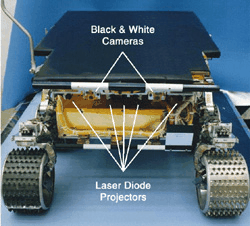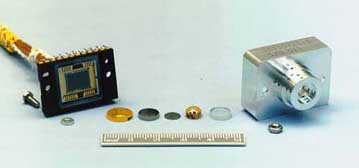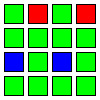Rover Camera Instrument Description

Table of Contents
The rover, named 'Sojourner', was essential to the achievement of the
major scientific goals of the Pathfinder mission because it carried
the Alpha Proton X-ray Spectrometer, or APXS, that analyzed rocks and
other surface materials. Aside from transporting the APXS, the rover
also contributed scientifically by carrying three cameras that yielded
a large quantity of image data. The discussion of the rover
'instrument' per se in this section will focus on the salient
characteristics of the three cameras, and not of the APXS. For a
complete discussion of the latter, see the instrument description for
the APXS.
Two front monochromatic camera/laser systems provided stereo viewing
and ranging, while the rear mounted camera was discriminant in the
red, green, and IR spectral bandwidths to produce color images.
Whereas the Imager for Mars Pathfinder (IMP) camera viewed the Martian
scenes from a fixed platform at spatial resolutions that diminished
with distance, the mobile rover was able to drive up to landforms,
including those hidden from the IMP, to image them at higher
resolution.
The rover cameras were built by the Microrover Flight Experiment Team
at the Jet Propulsion Laboratory.
The rover's Primary Mission was planned for seven sols (Martian days).
The rover was designed to interact with slightly more than 300 square
meters of Martian terrain, though initial operations were conducted
within a limit of 10 meters or less of the lander.
Primary objectives for the rover were 1) exit the lander as early as
practical on the basis of lander stereoscopic images, 2) send initial
vehicle performance and technology experiment data to the lander, 3)
move a few meters and repeat objective #2, 4) acquire and transmit
images showing the condition of the lander, 5) acquire images at the
end of daily traverses for navigation purposes, or encounter, acquire,
and transmit an image of a rock or soil patch for subsequent APXS
analysis, 6) deploy APXS on the imaged rock or soil patch, if
possible, for 1 to 10 hours duration for chemical analysis, 7) query
the APXS for final data and transmit interim and final data to the
lander, and 8) traverse diverse terrains and repeat objective #2.
An Extended Mission of 30 sols was planned and more than realized, as
the governing spacecraft, rover and site-related factors permitted
rover activities to continue for 81 sols. Extended Mission objectives
were similar to the Primary objectives, with technology experiments
amended to explore the diverse terrains further away from the
lander.
As during the Primary Mission, Extended operations of the rover
cameras were to yield a high resolution image dataset critical for
navigation purposes and geologic analysis of structures in rocks and
soil-like materials. The rover image data were to contribute to the
technology experiments by affording high resolution stereoscopic and
multispectral examination of 1) features targeted for APXS chemical
analysis, 2) slumped or eroded surface material that had been
excavated by the churning rover wheels, 3) aeolian effects on the
exposed, upturned material, and 4) overturned rocks. This would aid
in achieving the scientific objective of better understanding surface
material properties such as grain size, bulk density, friction angle,
cohesion, and compressibility, which could then be put in the larger
context of geologic features seen in the lander IMP images.
Of the ten Technology Experiments, rover camera images were acquired
to support the following six: a) Terrain Characterization, b) Basic
Soil Mechanics, c) Wheel Abrasion, d) Thermal Characterization, e)
Dead Reckoning and Path Reconstruction, and f) Vision Sensor
Performance. For a description of these experiments, refer to [MATIJEVICETAL1997A].
|
There were three imaging subsystems aboard the rover. Two broad-band
monochrome camera/laser systems were located on the forward part of
the rover, and a third camera was located on the aft part near the
APXS. The two front cameras, used in conjunction with laser stripe
projectors for hazard detection, provided images for stereoscopy and
measurements. The aft camera, which was rotated 90°, provided
spectral information while imaging the APXS target area, rover tracks,
and terrain.
The 'cameras' were CCDs clocked out by the rover Central Processing
Unit (CPU). The camera systems were capable of auto-exposure, block
truncation coding (BTC) data compression, bad pixel/column handling,
and image data packetizing.
The major components of the camera systems are described in detail
below.
|

(top view)

(bottom view)
|

MFEX Camera, Exploded View
Front Camera Specifications:
| CCD array size |
484 (vertical) x 768 (horizontal) pixels |

(Aft Camera Color Map) |
| Pixel size |
13.6 um (vertical) x 11.6 um (horizontal) |
| Full well |
60,000 electrons (manufacturer claims 80,000) |
| Output sensitivity |
10 uV/electron |
| Dynamic range |
> 60 dB |
| Dark Noise |
40 electrons rms |
| Dark Current |
< 0.5 nA/cm2 |
| Blooming suppression |
> 300 X |
| Maximum Data Rate |
14.3 MHz |
| Image lag |
negligible |
Aft Camera Specifications:
Same as the Front Camera specs, except that the CCD chip was
engineered as a Color Filter Array. The pixels were arranged in a
'field-staggered 3G' color mosaic filter pattern. In each 4x4 pixel
block, 12 were Green sensitive, 2 were Red sensitive and 2 were Blue
sensitive. The blue pixels were sensitive to both blue and infrared
wavelengths. Given that the camera optics blocked out much of the
light in the blue part of the spectrum, the 'blue' pixels were
essentially infrared pixels. (More information about the aft, color
CCD is available in [DLUNA&FROSINI1992] and [PARULSKIETAL1992].) The pixel map
for the color CCD is as follows:
This map repeats in both the row and column directions. This is the
orientation of the pixel map for a rotated image, and thus will have
to be rotated 90° to match the color map published by the
manufacturer of the CCD (Eastman Kodak Company).
Optical Material:
There were three elements that made up the optical subsystem: 1)
camera window, 2) objective lens, and 3) field flattener lens. Their
material makeup included optical grade sapphire and zinc selenide.
This was significant in that the zinc selenide effectively blocked
transmittance of most blue light. For a diagram of the optical
elements, see document [SEPULVEDA1994].
| Camera window |
Optical grade sapphire |
| Objective lens |
Optical grade zinc selenide |
| Field Flattener lens |
Optical grade zinc selenide |
General Camera Features:
The resolving power of the rover cameras contributed significantly to
the technology experiments measuring grain sizes in surface material.
The rover cameras were designed to be able to resolve fragments about
0.6 to 1.0 cm across at a nominal range of 0.65 m. Closer viewing of
the surface near the wheels could reduce these sizes by four-tenths,
and special situations (ie., close-up views of a rock 20 cm high)
could reduce these values by as much as one-tenth.
| Lens focal length |
4 mm |
| Forward camera separation |
12.56 cm |
| Approximate height above surface |
26 cm |
Fields of View:
| Forward cross track |
127.5° |
| Forward along track |
94.5° |
| Aft cross track |
94.5° |
| Aft along track |
127.5° |
| Forward Boresight Angle |
-22.5° |
| Aft Boresight Angle |
-41.4° |
Average Spatial Resolution per Pixel:
Spatial resolution is the product of the distance of an object or
surface from the camera and the camera resolution (in mrad/pixel). To
calculate the average spatial resolutions, a camera resolution of
0.003153 mrad/pixel was used.
| Forward cross track |
0.166° (2.897 mrad) |
| Forward along track |
0.195° (3.409 mrad) |
| Aft cross track |
0.195° (3.409 mrad) |
| Aft along track |
0.166° (2.897 mrad) |
The zinc selenide material contained in the camera fore optics (see Optical Material above) served to filter out most
light transmitted in the blue region below 500 nm. This effect
applied to all cameras.
The filter on the front cameras was to have a peak transmittance of
97% at the central wavelength, which is defined as:
W = 860 nm + 30 nm / -30 nm
For every 4 x 4 block of pixels in the aft Color Filter Array, 12 were
green, two were red, and two were infrared, allowing multispectral
imaging of surface materials. Compared to the response for the red
and green pixels, that of the infrared pixels was low. When exposure
time was increased to improve the dynamic range of the infrared
pixels, the impact was negative as light bled from the red and green
pixels into the infrared pixels. As a result, the aft color camera
was most useful in providing red and green color information. For a
schematic diagram showing the relative spectral responses of the aft
color camera, see Figure 5 in the [MATIJEVICETAL1997A].
| Forward Wavelength Sensitivity |
830 - 890 nm |
| Aft Wavelength Sensitivity |
500 - 900 nm |
Many optional command parameters are available to control the exposure
and processing. These include everything from exposure time to the
amount and type of data compression. All of this information is
attached to the image headers.
Laser ranging:
Proximity scanning using the lasers was controlled by a table of
camera/laser combinations. For each combination, a list of calibrated
scan lines was stored. For each laser at each line, the nominal spot
position, first-order scaling of pixel offset to height, and
correction scale factors for pitch and roll were stored.
Image capture:
Image capture was executed by applying low-level functions to manage
the acquisition, readout, and optionally, compression of the data.
Valid image data were in rows 6 through 489 and columns 0 through 767;
row 490 contained dark reference pixels. The data was packetized for
telemetry, with enclosed identifiers describing the exposure (in
milliseconds) and image region.
Auto exposure determination was indicated by an exposure time of zero.
Given an image region, an overexposed image was taken and the
brightest (saturated) pixel found. Then a geometric search of
exposure times was performed, until an image was found with an average
pixel value between 40% and 50% of saturation. Finally, exposure time
was reduced by 25% as many times as necessary until no more than 1% of
the pixels were within 5% of saturation. An exposure time of 1
indicated that the last computed auto exposure time was re-used. If
no auto exposure had been performed since the last wakeup, a new auto
exposure time was determined.
As part of the auto exposure, a shift factor was employed to manage
the A/D conversion from 12 bits to 8 bits. Proper auto exposure for
the front B&W cameras generally required a shift factor of 2,
while the aft color camera used a shift factor of 1.
Compression:
Used optionally on front camera B&W images only, the block
truncation coding (BTC) algorithm gave a fixed 4.9:1 compression
ratio, helping to reduce the communication time without unduly
sacrificing image quality. In pre-flight tests, a S/N ratio of 145:1
was achieved. Compression was performed on 16 column by 4 row blocks
of image data. When the BTC compression was performed on aft camera
images, a loss of color information resulted.
The overall approach to acquiring camera calibration data for the
rover was to capture images of a calibration target placed at two
distinct but known locations in front of the camera. The calibration
target was rigid with a known geometry, and consisted of a flat black
square with a 17 x 17 array of white circles with known separation
machined into its surface, mounted to a structural framework. The
rover was placed on a stable platform and oriented so that the forward
cameras faced the calibration fixture, with the fixture near the
center of the camera field of view. A theodolite system measured the
precise location of the rover and the four corners of the target. The
target was imaged by the forward rover camera. The target was then
moved backward approximately one meter, but still located near the
center of the cameras' field of view. The location of the target was
again determined by the theodolite system, and the target was again
imaged. The entire process was repeated with the rear rover camera
facing toward the target.
The data collected for the rover was then processed using a set of
programs, collectively referred to as CCAL, to produce the CAHV camera
models for each rover camera. A description of the CCAL software
follows.
CCAL
These programs have been written for calibrating cameras for use in
robotic machine vision. The programs were developed in the Robotics
Vehicles Group (known by other names in years past) of Section 345
(formerly 347) at the Jet Propulsion Laboratory. The camera models
are based on the linear models of Yakimovsky and Cunningham, were
extended to include radial lens distortion by Gennery, and were
further extended to include fish-eye lenses by Xiong and Gennery. The
calibration measurement and reduction algorithms were designed by
Gennery. For more information on the camera models, see the
references below.
There are a number of programs for performing camera calibration. All
of them assume that the cameras are mounted and/or aligned as needed
prior to calibration, and that the user has some method of obtaining
calibration images from the cameras stored into files. The file
format used is a local format call PIC. This format is very simple.
The first four bytes of the file are the integer number of rows in the
image. The next four bytes are the integer number of columns in the
image. Following these are the byte pixels in normal scan line order.
While the nominal storage of the 4-byte integers is big-endian on all
current systems (MSB first, LSB last), the software will recognize
little-endian integers as well.
Most of the CCAL programs display graphical data by using the X
windowing system, and therefore must be run under an X-based graphical
user interface (GUI).
Calibration Overview
Camera calibration is broken into two major stages. The first is the
collection of calibration data; the second is the reduction of those
data to form camera models.
The calibration data is a collection of 3D-to-2D correspondence
points. For each of a number of locations within the field of view of
the camera, it is necessary to determine both its 3D world coordinate,
and where it falls in the 2D image plane. The 3D locations of points
must be non-coplanar in order to be able to solve for the camera-model
parameters.
Two programs are provided to collect calibration data. One lets the
user indicate with a mouse click where each of 2D points falls. The
other does analysis of images showing a special calibration fixture in
known locations. The output of both of these programs is a data file
containing the 3D-to-2D correspondence data.
The next step involves using another program to reduce the data.
Other programs may then be used to examine the resulting camera
models.
Programs
The following is a brief overview of the calibration programs:
Ccal5d is used to make a manual collection of calibration
data. The user inputs 3D coordinates either interactively or from a
file and then specifies with a mouse click where in a displayed image
the corresponding 2D images points are located.
Ccaldots is used to analyze images of a special
calibration fixture in known locations. With minimal operator
initialization this program will determine 2D locations to sub-pixel
accuracy and match them up to the a priori 3D locations.
Ccaladj performs a least-squares fit of the calibration
data to the parameters of the camera models. It outputs the model
parameters along with covariance data. It can produce the old linear
perspective CAHV camera models, the newer CAHVOR models that include
terms for radial lens distortion, or the most recent CAHVORE models
that include a moving entrance pupil. Both perspective and fish-eye
lenses are handled in CAHVORE.
Ccalres graphically displays the residuals of the
calibration by examining the input data and comparing the input 2D
locations to the 2D locations computed with the camera model. The
user can scale the residuals for easy viewing.
Ccaldist displays the amount of distortion in a CAHVOR
camera model. It can render the display in a graphical form and in a
textual/numeric form. In the case of the numeric form, the user is
prompted for 2D image locations at which distortion information is
wanted.
The following links provide some additional information about topics
related to the Mars Pathfinder mission. You must be connected to the
Internet for most of these links to work, since they are located at
the Central Node of the Planetary Data System.




